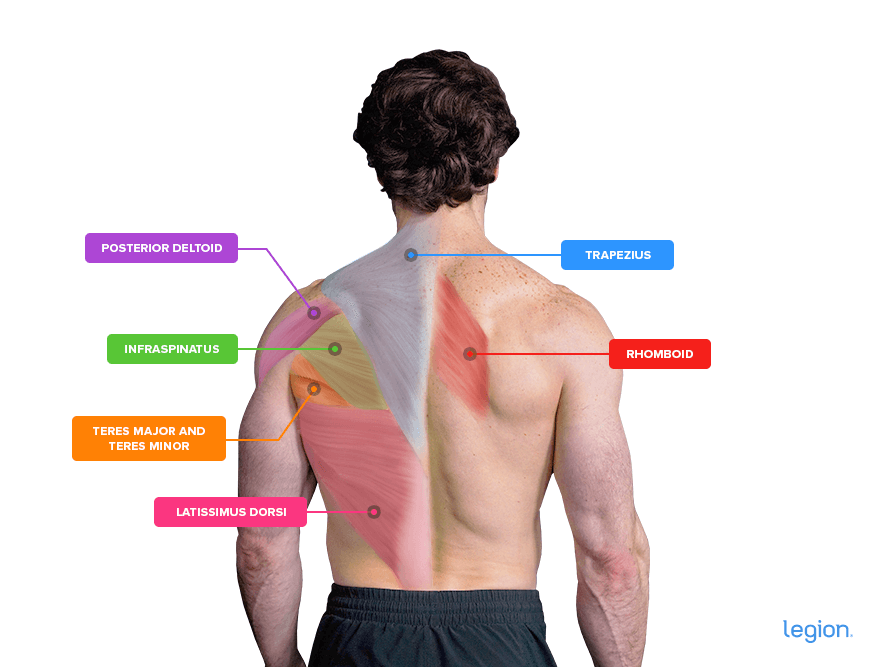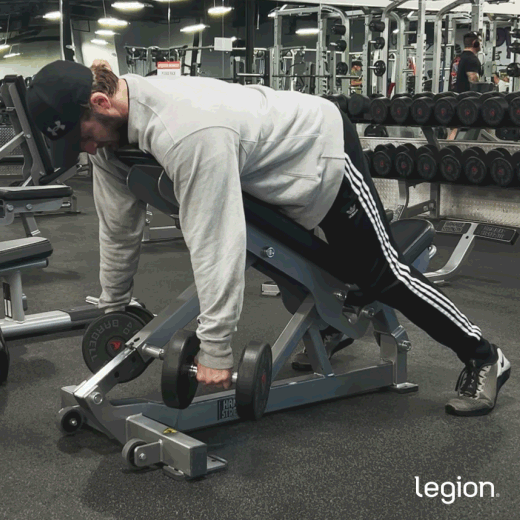The chest-supported row is an upper-body exercise that trains all the muscles in your back.
It’s unique among back exercises because it involves pulling a weight toward your torso while lying prone on a bench. This prevents you from using momentum to help lift the weight and ensures your back muscles do most of the work.
In this article, you’ll learn what the chest-supported row is, why it’s beneficial, how to perform it with proper form, the best chest-supported row alternatives, and more.
Want to know exactly how you should train to reach your fitness goals? Take our free 60-second training quiz and find out now.
What Is the Chest-Supported Row?
The chest-supported row is a back exercise that involves pulling a weight toward your torso.
It differs from similar exercises, including the one-arm dumbbell row and barbell bent-over row, because you perform it while lying prone on an incline bench.
The two most common variations of the chest-supported row are the chest-supported dumbbell row (or “chest-supported DB row”) and the chest-supported barbell row. While both variations are effective, most people find the dumbbell chest-supported row easier to set up and perform, so that’s the variation we’ll focus on in this article.
Chest-Supported Row: Benefits
Research shows that horizontal pulling exercises, like the chest-supported row, train your entire back, including your lats, rhomboids, traps, rear delts, infraspinatus, and teres major and minor.
Exercises that train several muscle groups simultaneously are called compound exercises. They’re useful because they allow you to lift heavy weights safely, which is generally better for muscle and strength gain. They’re also time-efficient since you don’t have to do several exercises to train each muscle group separately.
Strengthening your back muscles using exercises like the dumbbell chest-supported row also helps you lift heavy weights—you can think of it as the scaffolding that supports the rest of your body.
It keeps your upper body tight and prevents you from tipping forward in the squat, stops your spine from rounding in the deadlift, and creates a stable base during the bench press.
In other words, including exercises like chest-supported rows in your training boosts your performance on other key exercises.
Another benefit of chest-supported rows is that resting your chest on a bench prevents you from generating momentum with your hips and upper body to “cheat” the weight up. This forces your back muscles to do the majority of the work, which ensures they’re sufficiently stimulated by the exercise.
Furthermore, resting on a bench means you don’t support the weight with your spine, making the chest-supported row ideal for people training around a lower-back injury.
Chest-Supported Row: Muscles Worked
The chest-supported row works the . . .
- Latissimis dorsi
- Trapezius
- Rhomboids
- Teres major and minor
- Read deltoids
- Infraspinatus
It also trains your biceps to a lesser degree, too.
Here’s how those muscles look on your body:

How to Do the Chest-Supported Row
The best way to learn how to do the chest-supported dumbbell row is to split the exercise into three parts: set up, row, and descend.
1. Set Up
Adjust a bench to a 30 degree angle and place a dumbbell on either side of the bench toward the top end. Straddle the bench, place your chest against the pad, and plant your feet on the floor behind you, then reach down and grab one dumbbell in each hand.
2. Row
Keeping your elbows tucked 4-to-6 inches from your sides and your chest pinned to the pad, pull the weights toward your torso. Continue pulling until the weight touches your torso. As you lift the weight, pull your shoulders back, and at the top of each rep, squeeze your shoulder blades together.
(Tip: A helpful cue is to imagine touching the ceiling with your elbows.)
3. Descend
Reverse the movement and return to the starting position. This mirrors what you did during the row.
Don’t let the weight yank your arms back to the starting position or try to extend your arms slowly. The entire “extension” should be controlled but only take about a second.
Here’s how it should look when you put it all together:

The Best Chest-Supported Row Alternatives
1. Chest-Supported T-Bar Row
The main benefit of the chest-supported T-bar row is that you can change your grip width and orientation to find a position that’s most comfortable for you.
However, its slightly shorter range of motion compared to a dumbbell chest-supported row might make it marginally less effective for muscle and strength gain.
2. Chest-Supported Machine Row
The chest-supported machine row (or “seated chest-supported row”) is a variation of the chest-supported row that involves a chest-supported row machine. The chest-supported machine row is a great alternative to the regular chest-supported row for beginners because it requires less coordination and balance, is more straightforward to learn, and requires less setup.
3. Chest-Supported Rear Delt Row
In the chest-supported rear delt row, you flare your elbows as you row the weights so that your upper arms are almost perpendicular to your torso. This emphasizes your upper back muscles, especially your rear delts (the triangle-shaped muscles located behind your shoulder joints on your upper back), making the chest-supported rear delt row a good variation for those who want to prioritize shoulder development.
4. Incline Chest-Supported Row
In the incline chest-supported row, you increase the bench angle to 45-to-60 degrees. Performing the exercise on a higher incline shifts the emphasis from your mid back to your upper back, which makes the incline chest-supported row a useful chest-supported dumbbell row alternative for those wanting to develop their rear delts, rhomboids, and traps more than their lats.
5. Chest-Supported Barbell Row
The chest-supported barbell row allows you to lift heavier weights than when you use a pair of dumbbells, which is generally advantageous for muscle and strength gain. However, the downside of using a barbell is that it limits the range of motion, negating some of the exercise’s muscle- and strength-building potential.
The Best Supplements for Back Gains
Doing effective exercises like the chest-supported row is a big part of building a strong, muscular back. But if you want to make even faster progress, taking the right supplements can help.
To train harder, recover faster, and maximize growth from your back workouts, consider these three:
- Protein powder: Protein powder, such as Whey+ (Legion’s whey isolate) or Casein+ (Legion’s micellar casein), provides your body with the nutrients needed to build muscle tissue and recover from workouts.
- Creatine: Creatine boosts muscle and strength gain, improves anaerobic endurance, and reduces muscle damage and soreness from your workouts. For a natural source of creatine, try Legion’s creatine monohydrate, creatine gummies, or post-workout Recharge.
- Pre-workout: A high-quality pre-workout enhances energy, mood, and focus, increases strength and endurance, and reduces fatigue. For a top-tier pre-workout containing clinically effective doses of 6 science-backed ingredients, try Legion’s Pulse with caffeine or without.
(If you’d like even more specific advice about which supplements you should take to reach your health and fitness goals, take the Legion Supplement Finder Quiz, and in less than a minute, you’ll know exactly what supplements are right for you.)
Scientific References +
- Ronai, Peter. “Do It Right.” ACSMʼs Health & Fitness Journal, vol. 23, no. 4, 2019, pp. 32–37, https://doi.org/10.1249/fit.0000000000000492.
- Graham, John F. “Dumbbell One-Arm Row.” Strength & Conditioning Journal, vol. 23, no. 2, 1 Apr. 2001, p. 59, journals.lww.com/nsca-scj/Citation/2001/04000/Dumbbell_One_Arm_Row.14.aspx.










